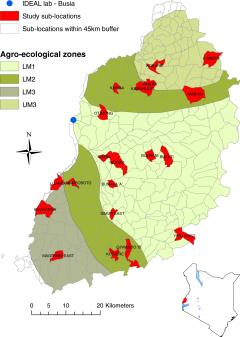High resolution genotypes and phenotypes
EERA is currently applying extensive statistical approaches to study the link between livestock genetics, disease resistance and survival and developing new high resolution phenotyping tools.

What is the research about?
The overall aim of this project is to establish high resolution genotypes and phenotypes, which will be used to identify novel genomic markers for growth, disease resistance and survival in lifestock.
EERA is carrying out this research within the Centre for Tropical Livestock and Genetics (CTLGH) which is committed to research-driven solutions that support improved livestock-based livelihoods and address the challenges of food security, health and well-being and gender equity for people in the tropics.
The IDEAL project

The Infectious Diseases of East African Livestock (IDEAL) project recruited a cohort of 548 Short Horn Zebu calves in Western Kenya at birth and followed them for the first year of their live to investigate predictors for health and production outcomes.
Over 15% of the calves died during their first 12 months of life, mostly from diseases caused by combinations of pathogens including Theileria parva (East Coast fever) and Haemonchus spp (parasitic roundworms). The data highlight the need for detailed knowledge of the burden that infectious diseases impose on livestock in this region.
The field work on this project finished in 2010. However, the samples and data continue to be utilised to answer animal health questions, because of the careful development of a well-documented biobank and open access database.
This current project has two principal objectives:
- To improve the genotypic and phenotype resolution for the calves from the IDEAL cohort project
- To use these new high resolution phenotypes and genotypes to identify novel genomic markers for growth, disease resistance and survival in East African Shorthorn Zebu cattle
High resolution phenotyping tools
We are currently developing high throughput, next-generation, deep sequencing technologies to quantify the species composition of parasitic haemopathogens and nematode infections in cattle populations in East Africa, as a tool to inform sustainable control strategies including genetic selection.
These techologies come in two forms:
Haemobiome
A Haemo pathogen detection tool (Haemobiome) was developed, based on sequencing of 16s/18s rDNA of haemopathogens common to livestock in sub-Saharan Africa, these include: Anaplasma sp, Ehrlichia sp. Theileria sp, Babesia sp and Trypanosoma sp.
Polymerase chain reaction (PCR) amplicons of 16S / 18S rDNA are generated and sequenced using the next-generation sequencing (NGS) platform.
Resulting sequencing data is processed using a custom bioinformatics pipeline. The benefit of this tool is that it allows unambiguous detection of pathogens up to species level, which is not possible with conventional techniques, such as microscopy and reverse line blot (RLB).
Nemabiome
Nemabiome technology will be used to unambiguously identify nematodes up to the species level based on sequencing of ITS-2 rDNA using NGS technology. The use of Faecal eggs versus the use of L3 larvae will be validated. The benefit of this tool is that it allows unambiguous detection of pathogens up to species level, which is not possible with conventional techniques, such as the McMaster technique.
Related links
- Infectious Diseases of East African Livestock (IDEAL) project
- Centre for Tropical Livestock and Genetics (CTLGH)
Selected publications
- Bronsvoort, B.M.C., Thumbi, S.M., Poole, E.J., Kiara, H., Auguet, O.T., Handel, I.G., Jennings, A., Conradie, I., Mbole-Kariuki, M.N., Toye, P.G. and Hanotte, O. (2013) Design and descriptive epidemiology of the Infectious Diseases of East African Livestock (IDEAL) project, a longitudinal calf cohort study in western Kenya. BMC veterinary research, 9(1), p.171. doi:10.1186/1746-6148-9-171

